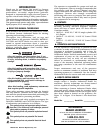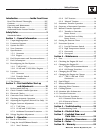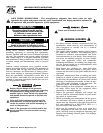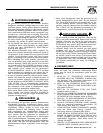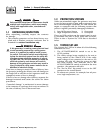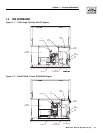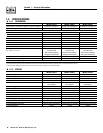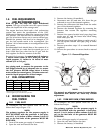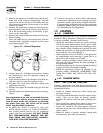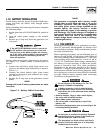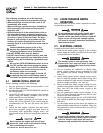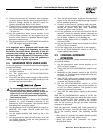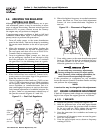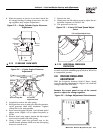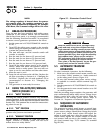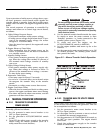
4. Remove the engine air in baffle located on the left-
hand side of the battery compartment. Two M6
screws are located on top of the baffle and two
M6 screws are located on the inside of the baffle
towards the back.
5. Remove the small hose clamp and hose from the
fuel regulator. It may be necessary to pry the hose
off of the brass fitting using a screwdriver to gen-
tly lift up the hose edge.
6. Remove the small brass hose fitting from the reg-
ulator casting.
7. Place the small fuel jet, thread side first, into the
threaded hole originally occupied by the brass
hose fitting (Figure 1.4).
Figure 1.4 - Demand Regulator
8. Using a short No. 2 Phillips screw driver, thread
the small fuel jet into the regulator casting. Do
not over tighten.
9. Apply thread sealant to the threads of the hose fit-
ting and replace it into the regulator body.
10. Re-attach the small hose and hose clamp and
tighten as necessary.
11. Replace the engine air in baffle using the four M6
screws.
12. Identify both brass adjustment screws on the reg-
ulator.
NOTE:
One adjustment screw can be accessed from the
front of the unit and the second can be accessed
from the back of the unit enclosure by removing
the plastic hole plug. The screw can be turned
with a long flat blade screwdriver.
13. To adjust the system to run on LP fuel, turn
BOTH adjuster screws 1/2 TURN CLOCKWISE.
The system should now be set for maximum
power and best perfomance. DO NOT, UNDER
ANY CIRCUMSTANCES, REMOVE THE SET
PINS FROM THE REGULATOR HOUSING.
THIS WILL VOID THE WARRANTY.
14. It may be necessary to make minor adjustments
to the preset adjustment screw settings to achieve
maximum power, particularly at higher altitudes.
If experiencing problems with the unit producing
maximum power, follow the procedure in Section
2.6 (Adjusting the Fuel Regulator).
1.9 LOCATION
1.9.1 GENERATOR
Install the generator set, in its protective enclosure,
outdoors, where adequate cooling and ventilating air
is always available. Consider these factors:
• Install the unit where air inlet and outlet openings
will not become obstructed by leaves, grass, snow,
etc. If prevailing winds will cause blowing or drift-
ing, consider using a windbreak to protect the unit.
• Install the generator on high ground where water
levels will not rise and endanger it.
• Allow sufficient room on all sides of the generator
for maintenance and servicing. A good rule is to
allow three feet of space on all sides.
• Where strong prevailing winds blow from one
direction, face the generator air inlet openings to
the prevailing winds.
• Install the generator as close as possible to the fuel
supply, to reduce the length of piping.
• Install the generator as close as possible to the
transfer switch. HOWEVER, REMEMBER THAT
LAWS OR CODES MAY REGULATE THE DIS-
TANCE.
1.9.2 TRANSFER SWITCH
1.9.2.1 7 kW, 12 kW and 15 kW Units
Transfer switches for use with these generators are
sold separately and can be purchased from Generac
Authorized Dealers.
• Install the transfer switch on a firm, sturdy sup-
porting structure.
• To prevent switch distortion, level the switch if nec-
essary. This can be done by placing washers
between the switch enclosure and mounting sur-
face.
• Never install the switch where water or any corro-
sive substance might drip onto the enclosure.
• Protect the switch at all times against excessive
moisture, dust, dirt, lint, construction grit and cor-
rosive vapors.
• Failure to utilize a Generac transfer switch with
this generator may void the warranty.
◆
◆
BRA
SS
H
OS
E
FITTIN
G
IDLE
C
IR
CU
I
T
P
O
R
T
U
1
T
TAP
1
/8
NP
T
BRA
SS
H
OS
E
FITTIN
G
F
U
EL H
OSE
S
MAL
L
F
U
EL
J
E
T
RE
GU
LAT
OR
H
OUS
IN
G
P
O
R
T
AD
JUS
TE
R
SC
REW
S
OU
TLET P
O
RT
S
Section 1 — General Information
Generac Air-cooled 7 kW, 12 kW and 15 kW Generators
8 Generac
®
Power Systems, Inc.



